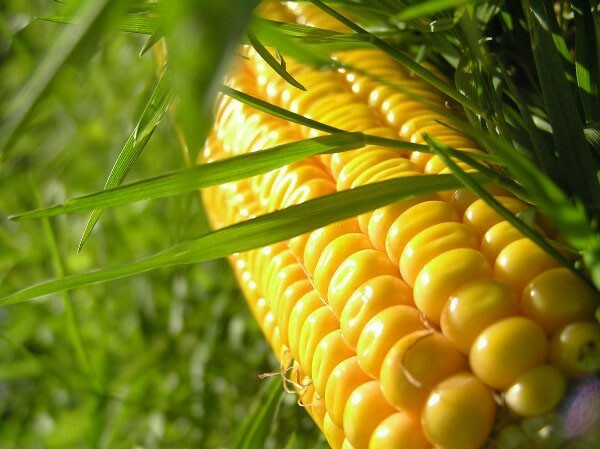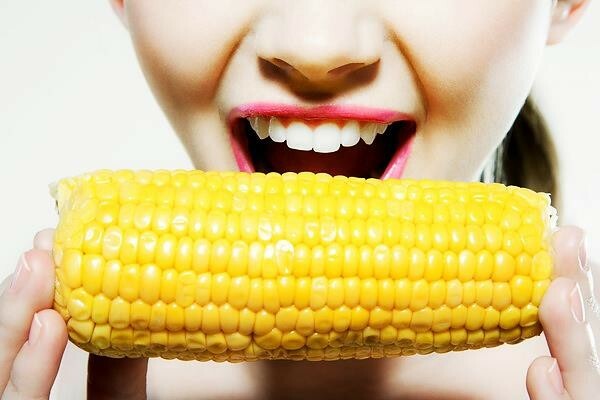- Chemical composition of
- Benefits of the main components of
Corn is one of the oldest cereals that was originally cultivated in Mexico. In their homeland, golden cobs have always been grown on a fairly large scale. What is the reason for this? First of all, due to the fact that this plant is very unpretentious, but because it is ideal for the local climate and gives rich harvests even under adverse weather conditions. In addition, the high caloric content of corn and its high nutritional value make it possible to quickly cope with the feeling of hunger.

Chemical Composition
Corn has a rich chemical composition, which contains important for the human body substances. Thanks to them, this product is able to bring significant benefits to our health and very quickly give a feeling of saturation. It is this property that this cereal is famous for.
Let's start by examining how much corn contains 100% of the corn:
- accounts for the largest portion of carbohydrates, and their share is about 22%;
- proteins in this product are much smaller - only 3.3%;
- fats - up to 1.5%.
In addition, slightly more than 7% is for food fibers, 10.3% for water, 1.2% for ash. Thus, it becomes obvious that corn is a high-carbohydrate product that can quickly and permanently satiate the body.
Note! A high percentage of carbohydrates makes corn very nutritious, and therefore, if you have excess weight, you must use it with caution!
If we talk about how many calories in corn, it will depend, first of all, on its variety. Caloric content of those that are most rich in carbohydrates is about 130 kcal per 100 g. But in most varieties that are cultivated on the territory of our country, it varies between 100 and 123 kcal per 100 g. However, this is indicative of an exclusively boiled product. The calorie content of raw grains is much higher and reaches 365 kcal per 100 g.
In canned corn, if consumed without syrup, in which it was marinated, the calorific value per 100 g is approximately 115-119 kcal.

But let's "drop" deeper and decompose the corn into smaller parts.
Vitamins
Corn is famous for its high content in the B vitamins. Among them:
- vitamin B1, the second name of which is thiamine - about 0.38 mg;
- vitamin B2, called riboflavin, its fraction is 0.2 mg;
- vitamins B3 and B5, which are also called pantothenic acid - 0.42 mg;
- vitamin B6, called pyridoxine - 0.62 mg;
- vitamin B9, represented by folate - 19 mcg.
In addition to the above vitamins, corn also contains A( PE) in the amount of 11 μg, alpha-carotene averaged 39.5 μg, beta-carotene averages 0.75 μg, Lutein + Zeaxanthin averagely 999.5 μg,vitamin E( TE), or alpha-tocopherol, - up to 0.5 mg, vitamin K, or phylloquinone, - not more than 0.3 μg, vitamin PP( NE) - no more than 3.63 mg.
Micro and macro elements
Now it's time to sound the constituents of corn from Mendeleyev's periodic system. Among the macroelements:
- potassium, which is present in the amount of a colony of 285 mg;
- phosphorus 210-300 mg;
- the proportion of magnesium is 125-128 mg;
- sulfur - 114 mg;
- silicon - 60 mg;
- of chlorine - 54 mg;
- sodium is somewhat less - about 35 mg;
- calcium a small fraction - no more than 7 mg.
As for trace elements, among them:
- about 2.7 mg of iron;
- approximately 2.21 mg of zinc;
- of the order of 314 μg of copper;
- 15.5 μg of selenium;
- 0.48 mg of manganese.
Amino acids
The maize contains the following amino acids:
- irreplaceable - agrinin, valine, histidine, isoleucine, leucine, lysine, methionine, threonine, tryptophan, phenylalanine;
- substitutable - alanine, aspartic, glutamic, glycine, proline, serine, tyrosine, cysteine;
- fatty - Omega3 and Omega6;
- saturated fatty - palmitic and stearic;
- monounsaturated fatty - palmitoleic and oleic;
- polyunsaturated fatty - linoleic and linolenic.

Benefits of the main components of
. Having examined the chemical composition of corn, it's time to go to the main thing - what is it useful for and what are the properties of its main components.
- Thiamine is one of the most important enzymes involved in carbohydrate and energy metabolism. It is he who gives our body a huge portion of energy. With its deficiency, serious disturbances in the functioning of the nervous system, the digestive tract, and also the heart and blood vessels can develop.
- Riboflavin provides a normal course of oxidation-reduction reactions and helps our organs of vision perceive colors and adapt quickly in the dark. With its lack, the skin and mucous membranes are often deteriorated, and normal susceptibility to light and twilight is disturbed.
- Pyridoxine is the main helper of our nervous system. It helps the immune system to protect the body from the harmful effects of factors that cause stress and overexcitation. In addition, this substance promotes the metabolism of tryptophan and normalizes the level of homocysteine. With a small consumption of pyridoxine, appetite decreases, the skin condition worsens and anemia gradually develops.
- Vitamin PP takes an active part in redox processes related to energy metabolism. With its deficiency, normal skin nutrition is disrupted, gastrointestinal function worsens and the nervous system suffers.
- Potassium regulates water, electrolyte, and acid balance and is responsible for the normal conduct of nerve impulses.
- Iron provides transportation of oxygen to each cell of our body and monitors the course of oxidation-reduction reactions. With its deficiency, hypochromic anemia develops, atrophic gastritis, fatigue increases, myocardiopathy can occur.
- Magnesium, a constituent of maize, provides energy metabolism, takes part in the synthesis of protein and maintains a normal level of certain macroelements, in particular, potassium, calcium and sodium. Its deficiency is fraught with the development of hypertension and various heart diseases.
- Phosphorus is involved in energy metabolism, mineralization of teeth, bone tissue and in the adjustment of acid-base balance. In case of insufficient intake, anorexia, rickets and anemia may develop.
- Manganese is one of the main builders of connective and bone tissue. It helps to remove excess cholesterol from the body and takes part in the synthesis of nucleotides - substances that play an important role in information processes that take place inside cells, and energy metabolism. Its low consumption leads to increased fragility of bones, lipid and carbohydrate metabolism is disturbed.
- Copper is necessary for the normal metabolism of iron, helps in the assimilation of proteins and carbohydrates. Supplies oxygen to all tissues of our body. With its deficiency, the normal formation of the skeleton, the work of the heart and the vascular system, and dysplasia of connective tissue develops.
- Zinc is an important substance that takes a direct part in the synthesis and disintegration of bju. With its lack, anemia is often observed, secondary immunodeficiency develops, sexual dysfunction and cirrhosis of the liver. Excess zinc disrupts the normal absorption of copper, which also leads to the development of anemia.
Corn is a source of important biologically active components that have a diverse effect on our body. They help to function properly for many organs and systems and prevent the development of various diseases. Include this product in your menu and be healthy!
